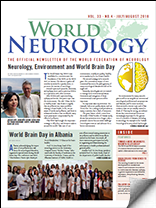John D. England, Editor-in-Chief,
Journal of the Neurological Sciences
I would like to take this opportunity to thank all of our authors, reviewers, and readers for helping to make the Journal of the Neurological Sciences a successful journal. The mission of our journal aligns exactly with the mission of the World Federation of Neurology. Thus, we strive to publish articles that improve world health by promoting prevention and care of people with disorders of the nervous system.

John D. England, MD
As such, our articles cover a wide spectrum, ranging from basic neuroscience to purely clinical and public health topics. With the full support of the World Federation of Neurology, we have been able to improve the quality of our journal. This is reflected in the latest metrics available from 2017.
The five-year impact factor (IF) is 2.536, and the IF has risen steadily over the past few years. Although this metric is important, other measures of a journal’s impact are available and are increasingly more important. During the last five years, the number of articles downloaded from our journal is 36,733,371. The four countries with the largest downloads are China, Japan, the U.S., and the U.K.; however, virtually every major country in the world is downloading our articles at an ever-increasing rate.
Our authors submit articles from all over the world, and they collaborate frequently with peers at different institutions and different countries. The review and publication times are now shorter than almost any other major journal. The average review time to first decision is 2.8 weeks, and the time to final decision is 5.7 weeks. Once an article is accepted, the online article publication time is a quick 0.3 weeks (2 days). With your continued support, I am confident that the journal will do even better in the next several years.
In our ongoing attempt to inform readers of important and interesting new developments in the journal, the editorial staff has selected two new “free-access” articles.
The article by Emmanuel Roze and colleagues summarizes the impact of an innovative simulation-based training program on long-term retention of neurological semiology in third-year medical students at the University Pierre et Marie Curie in Paris. The researchers named this teaching program The Move because it used mime-based role-play where students were trained to simulate patients with neurological syndromes. Thirty months after the teaching sessions, the students who participated in The Move were tested for long-term retention of neurological semiology and compared with a group of students who participated in only a standard teaching program in clinical neurology. Students who participated in The Move program achieved significantly higher scores in neurological semiology compared to the students who participated in only the standard teaching program. The authors conclude that simulation-based learning enhances learning of clinical neurology and suggest adoption of such programs in medical school curricula.
E. Roze, Y. Worbe, C. Louapre, et al., Miming neurological syndromes improves medical student’s long-term retention and delayed recall of neurology, J. Neurol. Sci. 391 (2018) 143-148.
The move: When neurosciences teach us to better teach neurosciences.
The accompanying Editorial by Marc Verin and Pascal Benquet emphasizes the conclusions and significance of the study by Emmanuel Roze and colleagues. They provide a background and context for understanding why active learning increases both performance and motivation through the process of cognitive embodiment. Incorporation of these newer teaching methods may result in enhancing the clinical proficiency of physicians and other health care providers.
M. Verin, P. Benquet. The move: When neurosciences teach us to better teach neurosciences, J. Neurol. Sci. 391 (2018) 149-150. •
